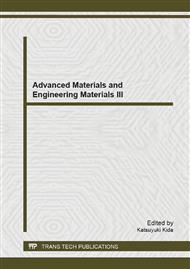[1]
CHAN W C W, NIE S M. Quantum dot bioconjugates for ultrasenstive nonisotopic detection[J]. Science, 1998, 281(5385): 2016-(2018).
DOI: 10.1126/science.281.5385.2016
Google Scholar
[2]
TAN W H, WANG K M, HE X X, et al. Bionanotechnology based on silica nanoparticles[J]. Med Res Rev, 2004, 24(5): 621-638.
Google Scholar
[3]
SONG E Q, WANG G P, XIE H Y, et al. Visual recognition and efficient isolation of apoptotic cells with fluorescent-magnetic-biotargrting multifunctional nanospheres[J]. Clin Chem, 2007, 53(12): 2177-2185.
DOI: 10.1373/clinchem.2007.092023
Google Scholar
[4]
BURNS A A, VIDER J, OW H, et al. Fluorescent silica nanoparticles with efficient urinary excretion for nanomedicine[J]. Nano Lett, 2009, 9(1): 442-448.
DOI: 10.1021/nl803405h
Google Scholar
[5]
LIU S L, ZHANG Z L, TIAN Z Q, et al. Effectively and efficiently dissecting the infection of influenza virus by quantum-dot-based single-particle tracing[J]. Acs Nano, 2012, 6(1): 141-150.
DOI: 10.1021/nn2031353
Google Scholar
[6]
LAI M, LEVY L, KIM K S, et al. Silica nanobubbles containing an organic dye in a multilayered organic/inorganic heterostructure with enhanced luminescence[J]. Chem Matr, 2000, 12(9): 2632-2639.
DOI: 10.1021/cm000178k
Google Scholar
[7]
ROSSI L M, SHI L F, QUINA F H, et al. Stober synthesis of monodispersed luminescent silica nanoparticles for bioanalytical assays[J]. Langmuir, 2005, 21(10): 4277-4280.
DOI: 10.1021/la0504098
Google Scholar
[8]
Gu Zhu Ying. Present Situation and Enlightenment of the Japanese hospitals nano measurement [J]. Journal of Nursing Zhi, 2005, 40 (7) : 550-552.
Google Scholar
[2]
Wang Yi, Zhang Liao, Liu Chengxia. Nurse to carry out the effect of nano measurement training intervention [J]. Chongqing Medicine, 2009, 38 (6) : 685-685, 687.
Google Scholar
[9]
Huang Lihua, Yao Yun Wu, Hubin Chun, et al. Nano measurement for nurses Cognition Investigation and Analysis [J]. Chinese Hospital Management, 2005, 25 (5) : 45-47.
Google Scholar


